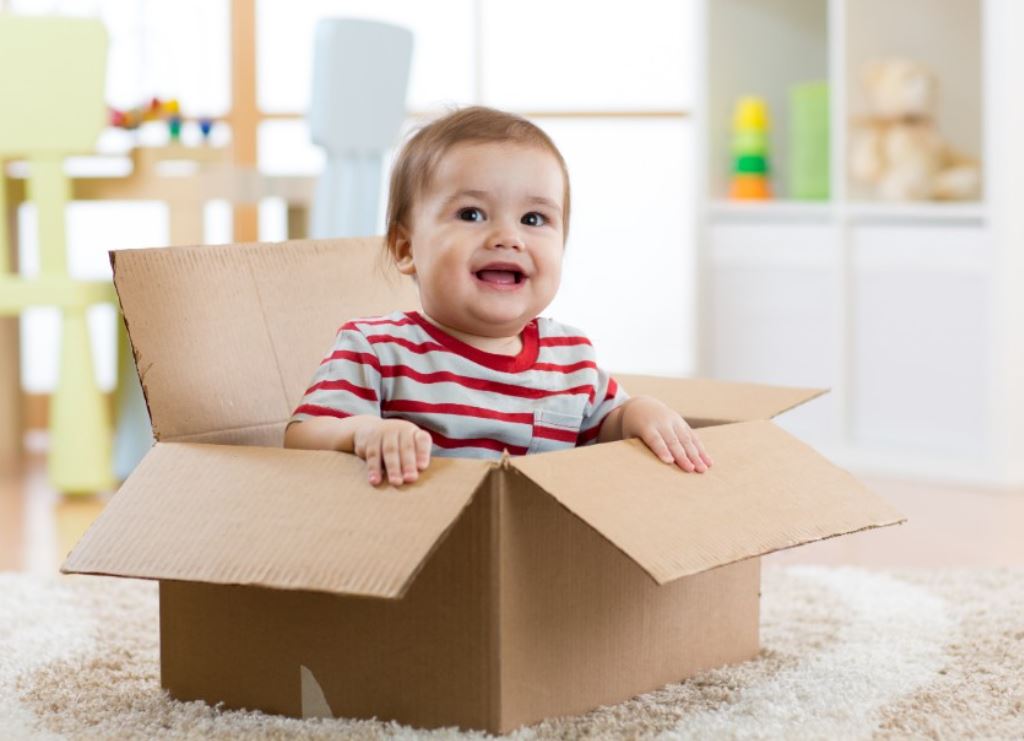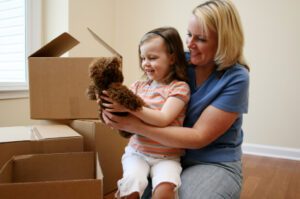
Moving With Kids – a Parent’s Guide
Moving with kids can be a challenging experience for parents. Whether it’s a local move or a long-distance relocation, the transition can be stressful for both children and adults. In this guide, ABC Moving Systems will explore essential tips and strategies to make the moving process smoother and less daunting for parents with kids.
Preparing Your Kids

Preparing your children for an upcoming move is a crucial first step to ensure a smoother transition. Communication is key; sit down with your kids and explain the reasons for the move in an age-appropriate way.
Address their questions and concerns honestly, emphasizing the positive aspects of the new location, like making new friends or exploring new opportunities.
Involving them in the planning process can make them feel more in control. Let them participate in decisions about their new room’s layout or choose paint colors.
Maintaining routines, even amidst the chaos of packing, provides a sense of stability. Try to stick to familiar bedtime rituals and mealtimes.
Additionally, decluttering and downsizing together as a family can be a valuable experience. Encourage your kids to sort their belongings into keep, donate, and discard piles. This not only reduces the amount to be moved but also helps them learn about decision-making and the importance of letting go of things they no longer need.
Finally, consider creating a scrapbook or memory box of their current home and neighborhood. This allows them to preserve memories and take a piece of their old life with them to the new place, providing a sense of continuity.
In essence, preparing your kids emotionally and involving them in the process can make the transition more manageable and less anxiety-inducing for them as you embark on your move together.
Choosing the Right Neighborhood
- Prioritize Safety: Research crime rates, traffic conditions, and proximity to emergency services to ensure a safe environment.
The Right Neighborhood - Check School Quality: Investigate the reputation and performance of local schools to provide your children with quality education.
- Family-Friendly Amenities: Look for neighborhoods with parks, playgrounds, community centers, and family-oriented activities.
- Proximity to Friends: Consider how close the new neighborhood is to your children’s friends or potential playmates.
- Commute Length: Analyze commute times to work and school, aiming for a manageable daily routine.
- Supportive Community: Seek out neighborhoods with a strong sense of community, where neighbors look out for one another.
- Diversity and Inclusivity: Choose an area that embraces diversity, promoting cultural enrichment and tolerance.
- Affordable Housing: Ensure the neighborhood aligns with your budget, taking into account not only rent or mortgage but also utility costs and property taxes.
Selecting the right neighborhood is a crucial aspect of moving with kids. It can significantly impact your children’s daily lives and overall well-being.
By considering safety, school quality, family-friendly amenities, and community support, you can find a neighborhood that suits your family’s needs and fosters a positive environment for your kids to thrive in during the transition.
School Transition

The process of moving with kids involves a crucial aspect: the school transition. This can be a significant source of stress and adjustment for children. To ease this transition, start by researching the new school district thoroughly. Find out about registration procedures, required documentation, and any specific requirements or deadlines.
Contact the new school as early as possible to schedule a visit. This gives your child a chance to familiarize themselves with the new environment, meet teachers, and ask questions. It’s also helpful to request copies of their school records from the previous institution to ensure a smooth academic transition.
Communication is key during this phase. Talk to your child about the upcoming changes, addressing any concerns they may have. Encourage them to express their feelings, and be empathetic to their worries. Assure them that you’ll be there to support them throughout the adjustment period.
Consider involving your child in extracurricular activities at the new school. This can be an excellent way for them to make friends with shared interests. Additionally, try to maintain a consistent routine, including regular school-related discussions, so that they feel more at ease in their new educational environment.
In conclusion, the school transition during a move is a significant aspect that requires careful planning and open communication. By preparing your child, involving them in the process, and maintaining routines, you can help them adapt to their new school and alleviate some of the stress associated with the move.
Involving Kids in Packing
- Ownership and Responsibility: Encourage your children to take ownership of their belongings during the packing process. This

Child participation instills a sense of responsibility and control.
- Pack a Personal Box: Let each child pack their “personal box” with their most cherished items, like toys, books, or a special blanket. This box can travel with them for immediate comfort in the new home.
- Sorting and Decluttering: Teach them to sort their possessions into categories: keep, donate, or discard. This not only reduces the volume to move but also helps them learn about decision-making.
- Labeling and Organizing: Involve them in labeling boxes with the contents or room names. This helps them understand the organization and eases the unpacking process.
- Creative Packing: Make packing fun by allowing them to decorate their boxes or create a packing list. This creativity can turn a potentially stressful task into an enjoyable one.
- Moving Day Role: Assign small tasks on moving day, such as carrying a backpack or supervising pet transportation. It gives them a sense of purpose and involvement.
- Farewell Ritual: Before leaving the old home, create a special farewell ritual where your child says goodbye to their room or the house. This can help with closure and emotional readiness for the move.
ABC Moving Systems has seen that involving kids in the packing process not only lightens the workload but also empowers them to cope with the changes. It transforms packing into a shared family experience and allows children to feel more connected to the move, reducing anxiety about the transition.
Moving With Kids – a Parent’s Guide: Moving Day Tips
Moving day can be particularly stressful when you have children. To make the process smoother, consider the following tips:
- Childcare: Arrange for childcare or playdates on moving day. Having kids out of the house during the hectic moving process can reduce anxiety for both them and you.
- Designated Space: Set up a designated area where kids can stay occupied with their favorite activities, snacks, and a few familiar belongings. This provides a sense of stability amidst the chaos.
- Safety First: Ensure your new home is childproofed before moving in. Child safety gates, outlet covers, and securing heavy furniture are essential steps.
- Moving Essentials Bag: Pack a “moving day essentials” bag with items like diapers, snacks, toys, and a change of clothes. Keep this easily accessible.
- Communicate: Keep your children informed about the moving schedule. Let them know what to expect and reassure them that their belongings will arrive at the new home.
- Familiar Items: Have their favorite stuffed animals, blankets, or comfort items readily available. Familiarity can provide comfort during the transition.
- Stay Calm: Children can pick up on your emotions. Try to remain calm and positive, even if the day gets hectic. Your composure can reassure them.
- Unpacking Priorities: Once at the new home, prioritize unpacking children’s rooms and belongings. Familiar surroundings can help them settle in more easily.
By planning ahead and considering your children’s needs on moving day, you can minimize stress and make the experience more manageable for both you and your kids as you embark on this new chapter in your lives.
Creating a Familiar Space
- Unpack Their Rooms First: Prioritize unpacking and setting up your children’s rooms to create a familiar and comforting space.

The Important Stuff - Decorate Together: Involve your kids in decorating decisions, allowing them to choose colors, posters, or decorations for their rooms.
- Bedtime Routine: Maintain a consistent bedtime routine, including familiar books or lullabies, to provide a sense of stability.
- Favorite Toys and Comfort Items: Ensure their favorite toys, stuffed animals, or comfort items are readily available to offer comfort during the transition.
- Family Spaces: Set up common areas like the living room with familiar furniture and items to create a sense of continuity.
- Photos and Memories: Display family photos and memories in prominent places to remind children of their past and create a comforting atmosphere.
- Explore the New Neighborhood: Take walks or bike rides together in the new neighborhood to familiarize your children with the surroundings.
- Meet the Neighbors: Encourage introductions to neighbors with children of similar ages to help your kids make new friends.
Creating a familiar space in your new home is essential to help children adjust. By prioritizing their rooms, involving them in decorating choices, and maintaining routines, you can provide a sense of comfort and stability during the transition. Additionally, exploring the neighborhood and meeting new friends can make the new environment feel more like home.
Supporting Emotional Well-being

Moving can evoke a range of emotions in children, from excitement to anxiety. As parents, it’s crucial to provide emotional support throughout this transition. Here are some strategies ABC Moving Systems suggests to help support your child’s emotional well-being:
- Open Communication: Encourage your child to express their feelings about the move. Be an active listener and validate their emotions, whether positive or negative.
- Empathy and Reassurance: Acknowledge their concerns and reassure them that it’s normal to feel a mix of emotions during a move. Provide comfort and a listening ear.
- Routine Maintenance: Stick to familiar routines as much as possible. Consistent meal times, bedtime rituals, and family activities can provide stability during a turbulent time.
- Quality Time: Spend quality time with your child, engaging in activities they enjoy. This strengthens your bond and provides a sense of security.
- Transition Plan: Create a transition plan together. Discuss how things will change and what will stay the same, helping them feel more in control.
- Say Goodbyes: Allow your child to say goodbye to friends, teachers, and familiar places. This can provide closure and ease the emotional transition.
- Foster New Connections: Encourage your child to make new friends in the new neighborhood or school. Playdates and social activities can help them feel more at ease.
- Patience: Be patient with behavioral changes or regressions that may occur during the adjustment period. Understand that it’s part of the process.
By actively supporting your child’s emotional well-being during a move, you can help them navigate the transition more smoothly and positively. Emotions are a natural part of the process, and with your guidance, children can adapt and even thrive in their new environment.
Settling into the New Home
- Unpack Together: Involve your children in the unpacking process, especially their rooms. This helps them regain a sense of

Easing Into New Home ownership and familiarity.
- Exploration Time: Allow your kids to explore the new house freely. Familiarize them with different rooms and spaces at their own pace.
- Neighborhood Exploration: Continue your walks or bike rides to explore the new neighborhood further. Point out nearby parks, schools, and play areas.
- Routine Restoration: Gradually reintroduce routines that may have been disrupted during the move. Regular mealtimes and bedtime schedules can provide comfort.
- Meet Neighbors: Make an effort to meet neighbors and their children. Playdates and friendly interactions can help your child establish connections.
- Engage in Activities: Enroll your child in local activities or clubs that align with their interests. This can facilitate new friendships and interests.
- Positive Reinforcement: Celebrate small victories and milestones, like successfully navigating their way to school or making a new friend.
- Create a Comfortable Space: Ensure their room is cozy and inviting. Let them arrange their belongings and personal items to their liking.
- Family Time: Dedicate family time to bond and create positive memories in the new home. Movie nights or game evenings can strengthen family ties.
By taking these steps, you can help your children settle into the new home more comfortably. This process may take time, but with your support and encouragement, they will gradually adapt to their new surroundings and thrive in their new environment.
Moving With Kids – a Parent’s Guide – Summary
As shown in this ABC Moving Systems summary, moving with kids presents unique challenges, but with careful planning and consideration, it can be a positive experience for the entire family. By preparing your children, involving them in the process, and providing emotional support, you can help them adjust to the new environment more easily. Choosing the right neighborhood and school, as well as creating a familiar space in the new home, are crucial steps in ensuring a successful transition.

